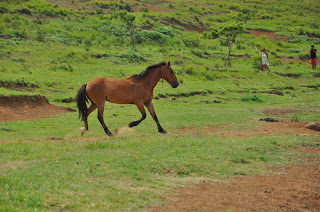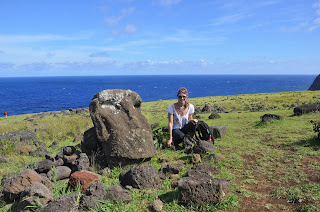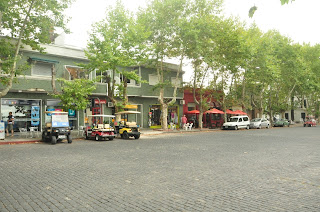Hello Friends!
I haven’t updated the blog in a few months, and I apologize
for that. A lot has been going on, and I
was more focused on doing than writing.
It’s time to catch up a bit, so get ready!
As I mentioned before, February was a busy month. I visited Uruguay with some friends, Eduardo
and I went to Easter Island, and my mom and sister came to visit. I’ve already
shared the events of my trip to Uruguay, so now it’s time to tell you all about
the most incredible place I’ve ever been- Easter Island.
Easter Island is located 2,182 miles from Chile, and 1,289
miles from the Pitcairn Islands. And
that’s it. These are the closest
inhabited lands, making Easter Island the most remote inhabited spot in the
world. The flight is five hours, and
upon arrival you really feel how isolated you are. For one thing, it’s extremely windy. There is nothing but ocean around you in all
directions so the wind has nothing to slow it down. Also, when you look out at the horizon you
can see the curve of the Earth. I know
it sounds like a trick of the eye, but scientists have confirmed that this is
actually possible, using gadgets that are far more high tech than my eyes.
 |
| That little white dot is Easter Island |
Of course, this is only the beginning of the Easter Island
magic. The island was settled by the
Rapa Nui people in the first century, and descendants have lived there ever
since. The story is that seven original
explorers set out from elsewhere in Polynesia and after (probably) a great deal
of time, came to the island that would be called, also, Rapa Nui. Considering how remote the island is, it
amazes me that they found it at all. Of
course, there may have been some less successful journeys previously. The population thrived for centuries, and in
that time they built hundreds of the famous Moai statues. The statues were built to represent their
ancestors, as the Rapa Nui practiced ancestor worship.
(One of) the incredible things about the Moai statues is
that they were all carved from rock in one specific volcano on the island. Easter Island is triangular in shape, and has
a volcano at each of its corners, plus many smaller ones around the rest of the
island. The rock from which the Moai are
carved is found in a smaller volcano, Rano Raraku, in the east.
All of the Moai were carved there, and only after they were
complete were they transported to their final locations around the island. Easter Island is only about 63 sq miles, but
when the only mode of transportation is rolling logs, this is a major
feat. To complicate matters further,
many of the Moai have hats, called Pukao,
which are carved from red volcanic rock.
This rock is found only in a quarry on the western side of the Island
called Puna Pau, so all Pukao had to be carved separately from the statues, and
brought together at the Ahu, or
altar. When the Moai were placed upright
on the Ahu, a ramp was fashioned in order to roll the Pukao onto the head of
the Moai.
 |
| A field of Pukao |
There are roughly 887 Moais on the Island, although not all
of them are outside, intact or upright.
Even though the Islanders were all called Rapa Nui, there were tribes on
the island, and they did not always get along.
Apparently during infighting, Moais of a certain lineage would be
toppled. In the centuries since, some
have been restored but there are still many that remain face down, often
broken. It’s a bit sad, but also very
powerful. They feel forgotten,
abandoned, and somehow remind you how isolated you are at that moment.
Our journey to the “Naval of the World” began with a
delay. LAN airlines delayed our flight
by nine hours, so instead of arriving at 5:00 PM, we arrived at 2:00 in the
morning. We were sort of exhausted, but
as soon as we got off the plane, the excitement woke us up.
We were met at the airport by one of the staff from our
hostal, presented with flower leis, and driven into the town of Hanga Roa. Hanga Roa is the main, and only, town on the
island. It’s small, but very sweet. We checked into our room and then opted to go
for a walk. There wasn’t much we could
see at 2:30 AM, and we couldn’t go very far since there are minimal street
lamps. When we got to the outskirts of
the town, we didn’t want to go much further for fear of getting lost, but we
spent some time just staring up at the skies.
I have never seen brighter stars in my life, and I know I keep harping
on this, but we really felt how distant we were from anywhere we knew.
We woke up the next morning, had a nice breakfast and set
off on rented bikes. We opted to ride
along the southern side of the island, from Hanga Roa towards the Rano Raraku
volcano. Along the way, we came across a
horse racing event which was part of the Tapati festival, which is held each
year. The festival lasts two weeks and
consists of several competitions, including several races, dancing, singing and
others. We watched the horse races for a
bit, ate some mini pineapples, and enjoyed the view.
However, before hiking up into the hill we went into a
little café at the base, where I met and melted for four tiny kittens. They had bells around their necks so you
could hear them coming, and they bounded around the café, chasing each other
and the customers. They were very nice
lunch companions.
Eduardo finally managed to drag me away from the kittens, and we started our hike. There’s a path that takes you along the hillside, and signs that kindly ask you not to climb on the Moai. I cannot imagine what kind of fool needs to be told that, but you can’t underestimate tourists. We heard that in 2008, a tourist chipped a piece off one of the Moai as a souvenir! He was fined $17,000 and banned from the island. What a fool.
After walking among the herd, we hiked up into the volcano
itself. It’s an extinct volcano, and
there is now a lake in the basin. We
took off our shoes and waded in a bit to cool off. We wanted to go swimming, but we stupidly
didn’t bring our bathing suits, and we didn’t think it would be appropriate to
go in au natural. We sat dangling our
feet in and watched some locals cutting up and binding banana leaves for one of
the main events of the Tapati festival.
The main event is a race down the hillside of another volcano, sliding
on a bundle of banana leaves. It’s
supposed to be one of the most exciting events of the year, so of course it was
taking place the day after our departure.
Still, we got to see some of the behind the scenes preparation. We also sat and watched some of the wild
horses run amok around the lake. The
island has a large wild horse population, and there were several living, or at
least hanging out, in this crater.
We left Rano Raraku, and continued by bike to the most
eastern corner of the island. Further up
is Ahu Tongariki, with 15 Moai. It’s pretty
impressive, as the altar is in the middle of rocky land with nothing around for
miles, so the Moai tower above everything.
 |
| The famous fifteen |
We continued on from there on a road that went up the
eastern side of the Island, and which all of our maps stated was well
paved. This is a lie. It was a painful road to ride, not least
because it was uphill the entire way. It
was also rocky and full of tree roots, and made me swore never to get on a bike
again. After the better part of an hour,
we made it to the point halfway up the eastern side of the island that connects
with the main road on the island, which is paved, thankfully. Of course, it’s also uphill. We rode back to Hanga Roa and promptly
collapsed.
After showering and having a short siesta, we walked down to
the main park near the harbor where there was a stage set up for the Tapati
festival. We ate some delicious food,
watched some performances, and then went back to the hostal and fell asleep
almost immediately.
The next morning, despite my pledge never to get on that
bike again, we rode to the western corner, to visit another extinct
volcano. We had the option of riding our
bikes to the top, and Eduardo thought it would be fun but I thought it would be
insane. We decided to leave the bikes at
the bottom and hike up through the trees.
Just walking up the hill was brutal, so I’m glad we opted to leave the
bikes.
At the top of the volcano, you can look down into the crater
to see another lake. You can’t go down
into the crater, but the view from above is stunning.
We continued along the edge of the crater to the farthest
point possible- the western corner of the volcano, and the island. Off the coast of these cliffs there are a huge
rocks/islands that were the site of the Birdman Competitions. This competition was held every year, when
leader of the different tribes would swim out to the first rock and wait for a
migratory bird to arrive and lay it's first egg. The first man to swim back to
the mainland with the egg was given the title of the Bird Man, and honored all
year.
 |
| It's even farther than it looks. |
We hiked back down, which was equally brutal and rode back
to town for lunch.
In the afternoon we traded the bikes for a motorcycle, and
headed for the beach. Surprisingly,
Easter Island only has one real beach, but it’s incredible. It’s on the north-eastern side of the island,
and the water is warm, the sand is fine, and there are of course Moais. We sat in the sun, played in the warm water
and took many pictures.
 |
| These poor guys can't even look at the beach. |
The next morning we headed north from the town on another
truly awful road, along the coast. We
found more ruined Moais and Ahus, but these seemed to be forgotten. If we wanted to, we could walk right up and
touch them, or break off a piece if we wanted to be total jerks. We were careful not to disturb them in any
way, but it was so incredible to walk between the fallen stones; we were
totally alone and it was a really special feeling.
We continued on our bumpy way and came to an area that was
known for the large underground caves.
We found what looked to be a hole covered by branches, so we jumped in
to investigate. “Hey, it goes in a
little bit!” “Hey, there’s another room!” “Hey, there’s a huge network of caves that
extends for miles!” We lit up our
headlamps and trekked through as much as we could. I don’t think I've ever been in caves like
these, and it was creepy and dark and thrilling.
We ended up at a wide opening with some basic steps to get into the caverns, and we realized that this was where most people entered the caves. Still, most people probably don’t go very far into the caves, so I like our way better.
 |
| Where we entered the caves |
 |
| Where everyone else enters the caves |
Our last stop with the motorcycle was Ahu Akivi, which is
home to the only Moai that are facing the ocean. There are seven of them, and they represent
the seven original explorers who originally came to the island. Again, I was amazed at how they could find
this little dot in the center of the ocean.
This Ahu was also fairly isolated, and by this time I was really
starting to understand the spiritual nature of the place. It’s hard to explain, but the Moai are so
stoic, so peaceful looking, and knowing what they represent and how long they’ve
been gazing out over the island gave me a feeling of tranquility. I’m also convinced that there must be some
kind of magnetic energy or something around the island itself, because I had a simultaneous
feeling of isolation and connectedness that made me feel so at peace.
 |
| The seven explorers |
 |
| And their view |
This feeling really hit me that evening, our last, when we
went to watch the sunset. Our flight
left at 10 PM, so we had time to return to the big park in the town where we
were told we could find the best views of the sunset. We came early, and we sat. Nothing more.
There were many people around, mostly tourists, and there was an air of
anticipation because the sunset spot is not a secret. As the sun went lower and lower, I couldn’t
help but feel a little sad that our visit was ending, but the view and the
sunset were so spectacular I also felt happy and grateful.
After dark, we could see people preparing for
the evening’s festivities of the Rapa Nui festival. From what I could see, the competition that
evening was going to be traditional dancing.
Unfortunately, we had to leave before it began. But, after the sun had set, a few singers
came out to sing traditional Rapa Nui music to entertain the waiting
crowds. I think that sitting on the
grass, looking at the Moais lit up by moonlight and torches, and listening to the beautiful
sounds of the music was one of the most special moments in my life. I was so completely content, and I could have
stayed for hours. Of course, we couldn’t
stay, and when we reluctantly left the park I felt like a spell had been
broken. We could still hear the music,
faintly, and I felt so drawn to it, but we had to keep walking back to
reality.
We left the island late in the evening, and slept on the
flight back to Santiago. When they woke
us up for our descent, it felt a little like I was waking up from a dream.
We want to go back someday, but logistically it could be
difficult. Still, I can confidently say
that Easter Island is the most special place I’ve ever visited, and one I’ll
never be able to forget.










































